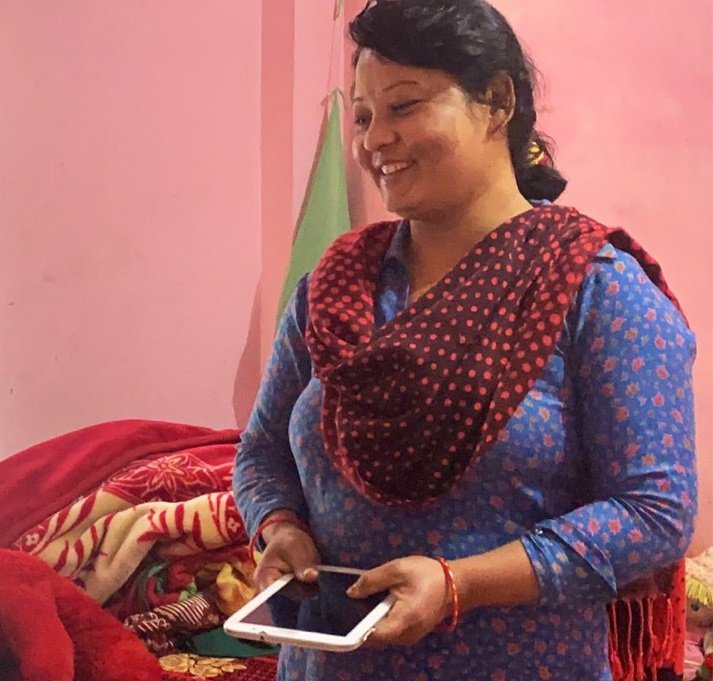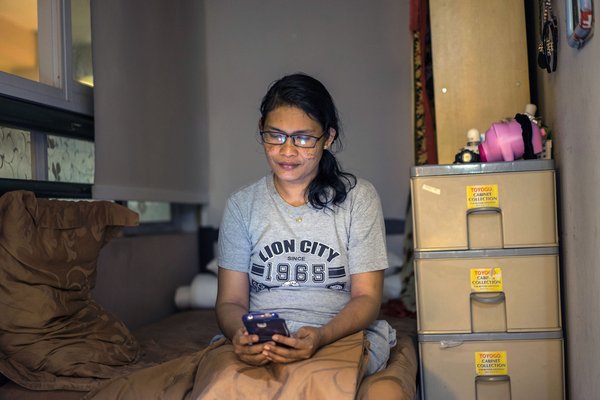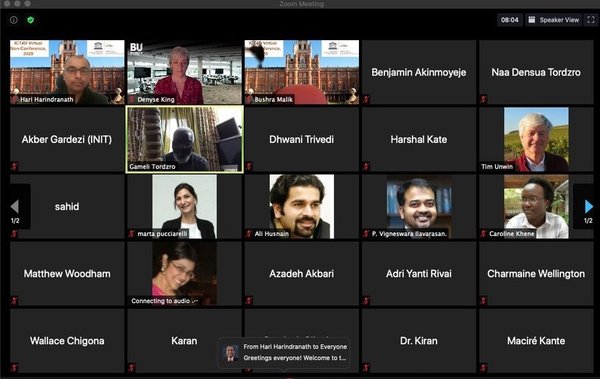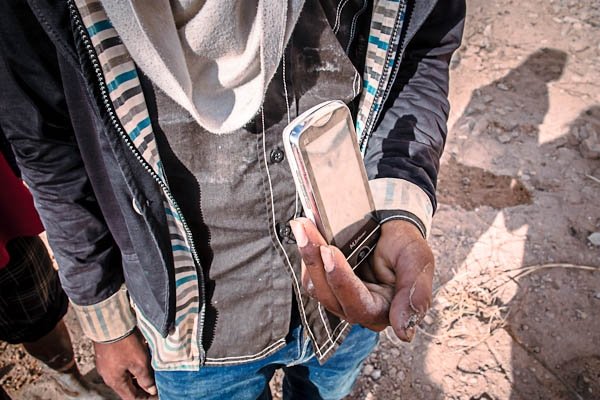
Sita Kumari, farmer, together in Nepal with Pratima Baral, Big Data scientist. Photo by C. de Bode/CGIAR. CC BY-NC-SA 2.0.
Digital interventions intended to benefit migrants are often developed by well-intentioned outsiders without sufficient understanding of migrants’ real needs or awareness of how they are already using such technologies. It is scarcely surprising that they fail to have their intended impact. Our approach within MIDEQ has begun to address this basic requirement by learning from migrants themselves at the very beginning of our intervention-research. After all, they know best about their own experiences.
The COVID-19 pandemic prevented us from using our preferred qualitative methods to understand these matters, and so we turned instead to using online surveys facilitated by the country teams in the China-Ghana, Ethiopia-South Africa, Haiti-Brazil and Nepal-Malaysia corridors in 2020 and 2021. This post highlights the main findings from these online surveys with migrants, returned migrants and migrants’ families in Malaysia, Nepal and South Africa (n > 250 in each country). We are subsequently supplementing these with online interviews and evidence from the MIDEQ wide comprehensive country surveys to provide the basis for more detailed analyses.
Five clear conclusions can already be drawn: context matters; most migrants never use apps specifically designed for them; the use of digital technologies increases through the migration process; migrants make very extensive use of smart phones and the Internet; and yet many migrants do not have sufficient skills or knowledge to be able to avail themselves safely of their full potential.
Context matters
It’s a truism, but migrants are very different from each other, not least in Africa, Asia and South America. Despite this, all too often digital “solutions” are developed for migrants (and refugees) as a monolithic uniform group. Our research has clearly shown that migrants in different occupations, and from different backgrounds tend to have significantly varying priorities in their uses of digital technologies. For example, those from Zimbabwe working in South Africa prioritised the use of digital tech for networking more than did those from Cameroon, Ethiopia or Ghana. Gender, though, was surprisingly not as significant a variable as we anticipated in influencing the usage of different types of technology or of what people liked or disliked about them. This was particularly so in our data from Malaysia and Nepal, although in South Africa there were some noticeable differences. Migrant women in South Africa liked the way that digital tech helps with networking and finding things out, whereas men placed greater emphasis on making money from their use. With dislikes, women in South Africa more than men particularly emphasised their potential to cause health problems and access to harmful materials.
What apps are used and why?
Our most important conclusion is that very few migrants ever use apps that have been specifically designed for them. Even when they claim that they have used such apps, almost all the “migrant apps” that they then named were generic ones such as Google, Facebook, WhatsApp or Imo. Only four of the 547 respondents in our surveys in Nepal and Malaysia, for example, mentioned that they used the Shuvayatra Safe Journey app which had been specifically designed for them.
Migrants and their families in these three countries make extensive use of a relatively small range of apps, almost exclusively those developed by global corporations from the USA. Questions were asked about the use of Chinese apps such as Alipay, Badu, QQ and WeChat, but these were very rarely used. Instead it was apps such as Facebook, Instagram, Messenger, WhatsApp and YouTube that were the daily go-tos for more than three quarters of all respondents. These were mainly used for contacting family members and friends, networking, and watching videos, although the preference of specific apps did vary a bit between countries.

Digital use through the migration process
A third interesting finding concerned how the use of digital tech varied at different stages in the migration process. Across all countries there was a general progression in the use of digital tech from thinking about migrating to their widespread use in the host countries. In the Nepal survey, for example, only 46% had used digital tech very frequently before migrating, whereas 85% used them very frequently while in the migration destinations. In the sample from South Africa, only 34% had used them very frequently before departure, with 89% do so while in their new locations. Migrants generally also served as a means through which digital tech was dispersed through their home communities, as illustrated in the image above. Enabling their families to have devices at home was a very important way through which they could continue to communicate together.
Which technologies are most used and why?
Mobile phones, especially smart phones, and the Internet were by far and away the dominant digital technologies used by migrants. In South Africa, 99% of the sample used mobile phones daily with the Internet being used daily by 94%; in Malaysia, the figures were very similar, with 98% using mobiles daily and 95% accessing the Internet daily. However, there were subtle differences in usage reported by migrants in the different countries for which we have now analysed data. In South Africa, for example, more than 90% of migrants used digital tech for all but one (work) of the 13 usage categories on which we focused, whereas in Nepal there were only five categories (audio calls, video calls, social networking, health and news updates) for which this was so. Laptops and desktop computers were generally used mostly for work, learning and education, as well as watching videos for entertainment. In Malaysia, digital technologies were liked mainly because they were easy to use and help with finding things out; in South Africa they were most liked for contacting people and accessing information.
How else do migrants want to use digital tech?
The most important findings for us were about what other things migrants wanted to use digital tech for, since this will guide the interventions that we facilitate with them and local tech communities in some of these countries. Interestingly, not many migrants or their families found it easy to respond to this question. However, those that did came up with a wide range of suggestions, including uses related to finance, communicating with family members, skills and employment, music, transport and visa checking. All of these are readily feasible now, which suggests that a key improvement in the digital lives of migrants might just be simply to help them better understand how to use their existing mobile devices. However, other suggestions provide novel potential uses for digital tech, such as “To do my house chores, e.g. cooking, cleaning, ironing etc.” and “to detect liars” or “evaluate what is true and false”. One interestingly said that “I would like to use it track other users. Knowing their communication angles and companion at the point of communication”.
Moving forward
Our intervention-research will use these findings along with those from our more qualitative research and the MIDEQ-wide survey to work with migrants and local tech developers to craft one or more interventions designed with them to reduce the inequalities associated with migration. Rather than reinventing the wheel, or building an app that might not be used by many migrants, we may well work in support of existing initiatives to help improve what they are already doing digitally by incorporating some of our findings. One of the most valuable interventions might simply be helping migrants use the tech that they already have more extensively, wisely and safely in their own interests. Including basic digital skills training in migrant programmes might after all be much more valuable than simply designing another app.



